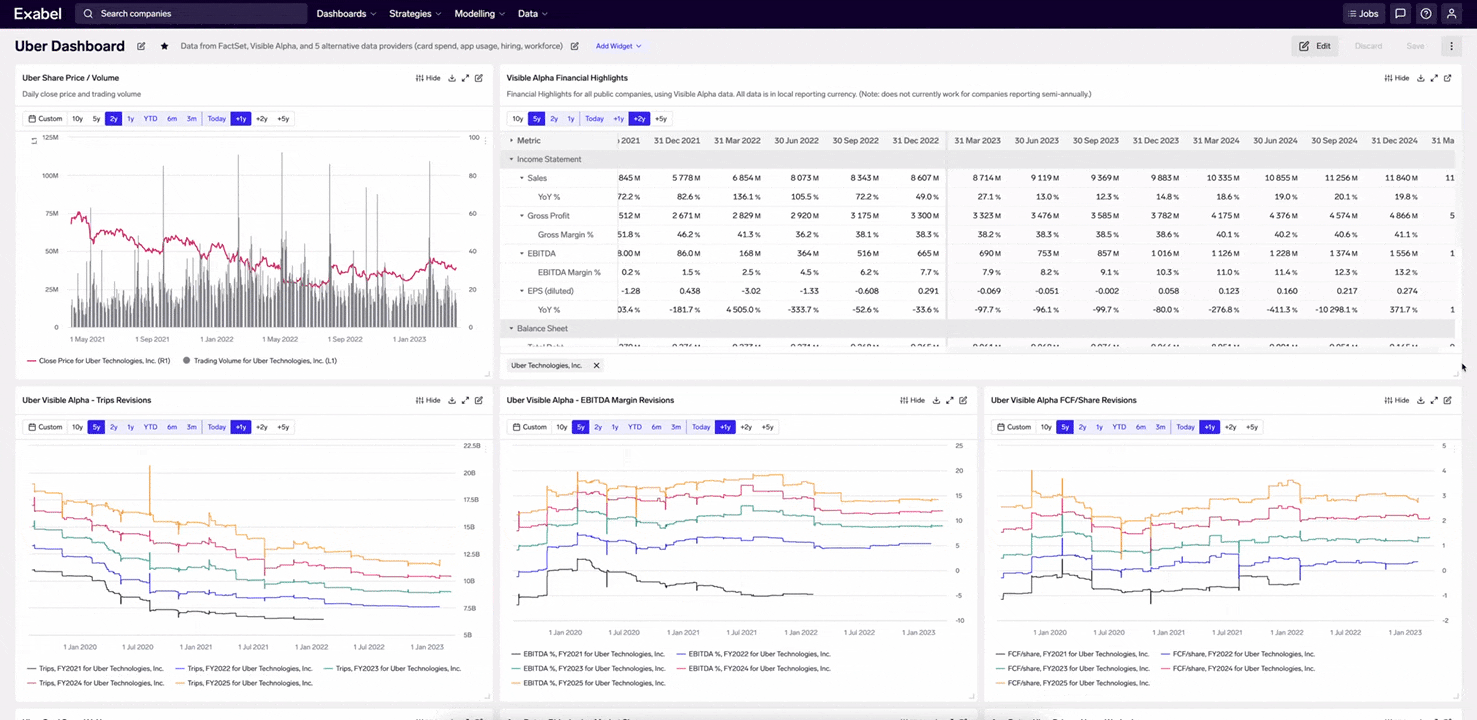March 2023 update
Customizable dashboard layouts, easier aggregation of signals over time, FactSet and Visible Alpha support for quarterly / semi-annual companies, and more control over forecasting functions.
New features
Customizable dashboard layouts
You may now customize your dashboard layouts for optimal consumption of alternative data insights. You may now resize and position widgets on a flexible grid, giving more space and prominence to key charts and tables.
If you would like to have more widgets than can fit on a single page, simply position them below and your dashboard will scroll to give you more space. The new dashboard layouts are independent of screen size, so other users will see a similar layout even if they are on a different screen size.
Existing dashboards with the old preset layouts are automatically migrated to the new layout feature, so they will continue to look the same as before.

Resizing and dragging widgets on a dashboard
Easier temporal aggregation
Analysts want the granular, high-frequency view of alternative data (daily, weekly, etc), but also the convenience of quickly switching to a quarterly / annual aggregate.
In charts, we've added new quick transform options to aggregate over time (eg over fiscal interims or years). These complement the existing moving average and change/relative change options. You can enable these by toggling "Quick transforms" under chart settings, and selecting from the options above the chart.
Any selected transforms are saved in the chart as well, so you can quickly restore your previous view.

Other new features
-
Financial models: Added options to customize the number formatting for each row. These options can be set while editing a financial model, when adding a new row or editing an existing row.
The following can be customized. (We are also looking to bring similar customization of number formatting to charts and dashboard tables.)
- Number of decimal places
- Units: percentage, percentage points, basis points
- Suffixes: auto (default), none, thousands, millions, billions, trillions
-
In-app feedback: Added a feedback page to post feedback and vote for items.
Improvements
- Dashboards: Improved, cleaner user interface for chart and financial model widgets.
- Signal explorer - correlations: Added date range selector in the correlation view to more easily view and change the period over which correlations are calculated.
- Signal explorer: Updated the signal transformation menu (accessible from the
f(x)button when editing a signal) to utilize the newresample()andcompany_calendar()DSL functions. - Financial models: Improved styling for rows with warnings or errors.
- DSL: New
freqparameter for functions to retrieve FactSet (actual(),estimate(),fundamental()) and Visible Alpha (va_actual()andva_consensus()) data. Thefreqparameter accepts the sameFQ/FS,FQ,FS,FYetc options introduced with the new company calendar. - DSL - forecasting
- Added support for specifying sigma parameters in Unobserved Components forecasts.
- Added burn and harmonics parameters to Unobserved Components forecast model.
- Support retrieving the
freq_seasonalcomponent of an Unobserved Components model. - Improve handling of missing values in SARIMA and Unobserved Components forecast models.
Deprecations
- DSL: deprecated the
fiscal_calendar()function, which will be removed on 2024-03-31. We recommend usingcompany_calendar()instead which is more robust and flexible. See our launch announcement and deprecation notice. - DSL: deprecated the
periodargument inactual(),estimate(),fundamental(),va_actual()andva_consensus()along with similar functions. We recommend switching to use the newfreqparameter described above, and on the DSL reference for FactSet and Visible Alpha.
Bug fixes
- Fixed drag & drop behaviour not working in Firefox.
- Library: Increased clickable checkbox area for item selection, enabling easier multi-selection of Library items.
- DSL: Support
afpandrdalignment for FactSet advanced reporting numbers, which are retrieved via thefundamental()function (DSL reference). This was previously returning errors. - DSL: Fix
fpalignment forva_consensus()for future fiscal periods.